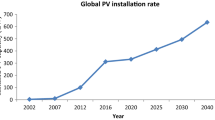Abstract
In the current work, the impacts of convector factors of a panel radiator regarding heat output and total weight have been investigated using a machine learning algorithm. An artificial neural network model, widely evaluated by machine learning algorithms, has been created to determine the heat output and total weight values of panel radiators. There are 10 neurons in the hidden layer of the machine learning model, which was trained using 111 numerically obtained data sets. A comprehensive numerical investigation has been done for dissimilar geometrical dimensions of convectors evaluated in panel radiators and validated with experimental results. Afterward, the Levenberg–Marquardt structure has been employed as the training one in the multilayer perceptron network structure. The heat output and total weight outcomes acquired from the artificial neural network have been contrasted with the computational data and the compatibility of the data has been examined comprehensively. Furthermore, various performance parameters have also been determined and the estimation performance of the neural network has been examined thoroughly. The mean deviation values for the thermal power and weight values gained from the network structure have been determined as 0.04 and 0.004%, in turn, and the R-value has been obtained as 0.99999. The investigation outcomes indicated that the proposed neural network can forecast the heat output and total weight values of the panel radiator with very high accuracy.














Similar content being viewed by others
Data Availability Statement
This manuscript has associated data in a data repository. [Authors’ comment: Data sharing not applicable to this article as no datasets were generated or analysed during the current study.]
Abbreviations
- AI:
-
Artificial intelligence
- ANN:
-
Artificial neural network
- BP:
-
Back propagation
- CFD:
-
Computational fluid dynamics
- c p :
-
Specific heat (J/kg K)
- d :
-
Distance of opposing convectors (mm)
- D i :
-
Inlet diameter of radiator (mm)
- FF:
-
Feed forward
- h :
-
Enthalpy (J/kg K)
- H :
-
Convector height (mm)
- k :
-
Conductivity (W/m K)
- L :
-
Trapezoidal height of convector (mm)
- m :
-
Panel radiator weight (kg)
- \(\dot{m}\) :
-
Mass flow rate (kg/s)
- MLP:
-
Multilayer perceptron
- MSE:
-
Mean squared error
- PCCP:
-
Panel-convector-convector-panel
- PN:
-
Pitch number
- Q :
-
Heat output (W)
- Ra:
-
Rayleigh number
- Re:
-
Reynolds number
- T :
-
Temperature (°C)
- W :
-
Panel width (mm)
- X :
-
Variable
- x, y, z :
-
Coordinates
- e :
-
Excess
- f :
-
Film
- i :
-
Inlet
- o :
-
Outlet
- s :
-
Surface
- β :
-
Coefficient of thermal expansion (1/K)
- \(\mu\) :
-
Dynamic viscosity (kg/m s)
- \(\nu\) :
-
Kinematic viscosity (m2/s)
- ρ :
-
Density (kg/m3)
References
T. Calisir, H.O. Yazar, S. Baskaya, Determination of the effects of different inlet-outlet locations and temperatures on PCCP panel radiator heat transfer and fluid flow characteristics. Int. J. Therm. Sci. 121, 322–335 (2017)
T. Calisir, H.O. Yazar, S. Baskaya, Thermal performance of PCCP panel radiators for different convector dimensions—an experimental and numerical study. Int. J. Therm. Sci. 137, 375–387 (2019)
A.K.A. Shati, S.G. Blakey, S.B.M. Beck, The effect of surface roughness and emissivity on radiator output. Energy Build. 43, 400–406 (2011)
J.A. Myhren, S. Holmberg, Performance evaluation of ventilation radiators. Appl. Therm. Eng. 51, 315–324 (2013)
J.A. Myhren, S. Holmberg, Improving the thermal performance of ventilation radiators—the role of internal convection fins. Int. J. Therm. Sci. 50, 115–123 (2011)
M. Maivel, M. Konzelmann, J. Kurnitski, Energy performance of radiators with parallel and serial connected panels. Energy Build. 86, 745–753 (2015)
M. Prek, G. Krese, Experimental analysis of an improved regulation concept for multi-panel heating radiators: Proof-of-concept. Energy 161, 52–59 (2018)
Z. Liu, W. Xu, Z. Li, L. Zhang, J. Li, A. Li, A. Feng, Research on heating performance of heating radiator at low temperature. J. Build. Eng. 36, 102016 (2021)
S.M.B. Beck, S.C. Grinsted, S.G. Blakey, K. Worden, A novel design for panel radiators. Appl. Therm. Eng. 24, 1291–1300 (2004)
M. Embaye, R.K. Al-Dadah, S. Mahmoud, Effect of flow pulsation on energy consumption of a radiator in a centrally heated building. Int. J. Low-Carbon Technol. 11, 119–129 (2016)
M. Embaye, R.K. Al-Dadah, S. Mahmoud, Thermal performance of hydronic radiator with flow pulsation—numerical investigation. Appl. Therm. Eng. 80, 109–117 (2015)
M. Embaye, R.K. Al-Dadah, S. Mahmoud, Numerical evaluation of indoor thermal comfort and energy saving by operating the heating panel radiator at different flow strategies. Energy Build. 121, 298–308 (2015)
L. Brady, M. Abdellatif, J. Cullen, J. Maddocks, A. Al-Shamma’a, An investigation into the effect of decorative covers on the heat output from LPHW radiators. Energy Build. 133, 414–422 (2016)
A. Menendez-Diaz, C. Ordonez-Galan, J.B. Bouza-Rodriguez, J.J. Fernandez-Calleja, Thermal analysis of a stoneware panel covering radiators. Appl. Energy 131, 248–256 (2014)
K. Gelis, Factorial experimental design for second law analysis of PRs as a function of radiator dimension. J. Build. Eng. 43, 102872 (2021)
K. Gelis, E.F. Akyurek, Entropy generation of different PR types: design of experiments using response surface methodology (RSM). J. Build. Eng. 41, 102369 (2021)
L. Garelli, G.R. Rodriguez, J.J. Dorella, M.A. Storti, Heat transfer enhancement in panel type radiators using delta-wing vortex generators. Int. J. Therm. Sci. 137, 64–74 (2019)
A.R. Rahmati, A. Gheibi, Experimental and numerical analysis of a modified hot water radiator with improved performance. Int. J. Therm. Sci. 149, 106175 (2020)
D. Akin, Computer aided design of experiments, MSc Thesis Dokuz Eylul University, Turkey, (2007)
P.C. Lindstrom, D.E. Fisher, C.O. Pedersen, Impact of surface characteristics on radiant panel output. ASHRAE Trans. 104, 1079–1088 (1998)
Y. Yedikardes, I. Teke, Effect of louvres on the thermal efficiency of PRs. Int. Commun. Heat Mass Transf. 88, 160–170 (2017)
D. Risberg, M. Risberg, L. Westerlung, CFD modelling of radiators in buildings with user-defined wall functions. Appl. Therm. Eng. 95, 266–273 (2016)
C. Brembilla, M. Soleimani-Mohseni, T. Olofsson. Transient model of a PR. Proceedings of BS2015: 14th Conference of International Building Performance Simulation Association, Hyderabad, India, 7–9 Dec 2015
T. Calisir, S. Baskaya, The influence of different geometrical dimensions of convectors on the heat transfer from PRs. SN Appl. Sci. 3, 284 (2021)
D. Wang, W. Li, Y. Liu, Y. Chen, L. Hu, H. Du, Non-uniform operative temperature distribution characteristics and heat-source-controlled core-area range of local heating radiators. Build. Simul. (2022). https://doi.org/10.1007/s12273-022-0924-x
R. Karimpour, A.R. Rahmati, A. Gheibi, Thermal performance and energy saving investigation in a modified baseboard radiator and compare it with conventional heating systems—experimental and CFD approach. Heat Transfer 50, 5020–5048 (2021)
T. Calisir, A.B. Çolak, D. Aydin, A.S. Dalkilic, S. Baskaya, Artificial neural network approach for investigating the impact of convector design parameters on the heat transfer and total weight of panel radiators. Int. J. Therm. Sci. 183, 107845 (2023)
T. Calisir, Numerical and experimental investigation of water channel, panel and convector separately and all together to enhance thermal output of panel radiators. PhD thesis, Gazi University (2017)
T. Calisir, S. Baskaya, H.O. Yazar, S. Yucedag, Enhancement of heat output of panel radiators using numerical techniques. Proceedings of the 2nd Thermal and Fluid Engineering Conference, TFEC2017, Las Vegas, NV, USA, 2–5 Apr 2017
EN 442–2. Radiators and convectors—part 2: test methods and rating (2015)
Y. Cengel, A. Ghajar, Heat and mass transfer: fundamentals and applications (McGraw-Hill, Boston, 2019)
T. Calisir, H.O. Yazar, S. Baskaya, Determination of the effects of different inlet-outlet locations and temperatures on PCCP panel radiator heat transfer and fluid flow characteristics. Int. J. Therm. Sci. 121, 322–335 (2017). https://doi.org/10.1016/j.ijthermalsci.2017.07.026
Mentor Graphics, FloEFD Technical Reference, Software Version 14, (2014)
A.B. Çolak, Developing optimal artificial neural network (ANN) to predict the specific heat of water based yttrium oxide (Y2O3) nanofluid according to the experimental data and proposing new correlation. Heat Transf. Res. 51(17), 1565–1586 (2020)
A.B. Çolak, An experimental study on the comparative analysis of the effect of the number of data on the error rates of artificial neural networks. Int. J. Energy Res. 45(1), 478–500 (2021)
A.B. Çolak, T. Güzel, O. Yıldız, M. Özer, An experimental study on determination of the shottky diode current-voltage characteristic depending on temperature with artificial neural network. Phys. B 608, 412852 (2021)
A.B. Çolak, Experimental analysis with specific heat of water based zirconium oxide nanofluid on the effect of training algorithm on predictive performance of artificial neural network. Heat Transf. Res. 52(7), 67–93 (2021)
O. Acikgoz, A.B. Çolak, M. Camci, Y. Karakoyun, A.S. Dalkilic, Machine learning approach to predict the heat transfer coefficients pertaining to a radiant cooling system coupled with mixed and forced convection. Int. J. Therm. Sci. 178, 107624 (2022)
A.B. Çolak, O. Yıldız, M. Bayrak, B.S. Tezekici, Experimental study for predicting the specific heat of water based Cu-Al2O3 hybrid nanofluid using artificial neural network and proposing new correlation. Int. J. Energy Res. 44(9), 7198–7215 (2020)
S. Öcal, M. Gökçek, A.B. Çolak, M. Korkanç, A comprehensive and comparative experimental analysis on thermal conductivity of TiO2-CaCO3/Water hybrid nanofluid: proposing new correlation and artificial neural network optimization. Heat Transf. Res. 52(17), 55–79 (2021)
A.B. Çolak, Y. Karakoyun, O. Açıkgöz, Z. Yumurtacı, A.S. Dalkılıç, A numerical study aimed at finding optimal artificial neural network model covering experimentally obtained heat transfer characteristics of hydronic underfloor radiant heating systems running various nanofluids. Heat Transf. Res. 53(5), 51–71 (2022)
T. Calisir, S. Baskaya, H.O. Yazar, S. Yucedag, Enhancement of heat output of panel radiators using numerical techniques, TFEC-IWHT2017, Las Vegas, USA, 2–5 Apr 2017
Acknowledgements
Ministry of Science, Industry, and Technology of Turkey (Grant No. 0641.STZ.2014) for financial support and Demir Döküm A.Ş. are thankfully acknowledged.
Funding
Bilim, Sanayi ve Teknoloji Bakanliği, 0641.STZ.2014, Senol Baskaya.
Author information
Authors and Affiliations
Corresponding author
Ethics declarations
Conflict of interest
The authors stated that there is no conflict of interest in this study.
Rights and permissions
Springer Nature or its licensor (e.g. a society or other partner) holds exclusive rights to this article under a publishing agreement with the author(s) or other rightsholder(s); author self-archiving of the accepted manuscript version of this article is solely governed by the terms of such publishing agreement and applicable law.
About this article
Cite this article
Calisir, T., Çolak, A.B., Aydin, D. et al. Research on the influence of convector factors on a panel radiator’s heat output and total weight with a machine learning algorithm. Eur. Phys. J. Plus 138, 43 (2023). https://doi.org/10.1140/epjp/s13360-022-03622-6
Received:
Accepted:
Published:
DOI: https://doi.org/10.1140/epjp/s13360-022-03622-6




